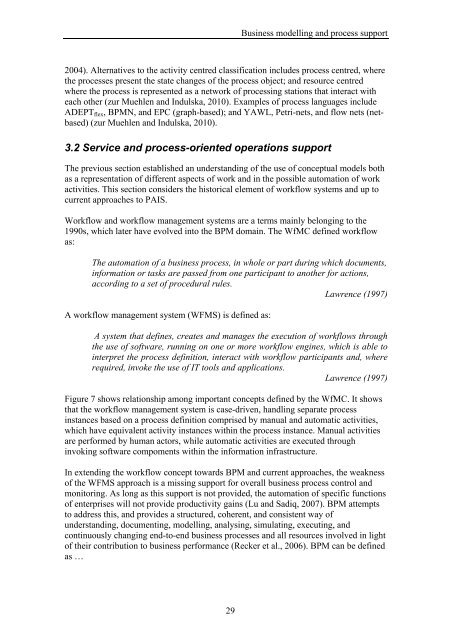Multi-channel provisioning of public services - Department of ...
Multi-channel provisioning of public services - Department of ...
Multi-channel provisioning of public services - Department of ...
You also want an ePaper? Increase the reach of your titles
YUMPU automatically turns print PDFs into web optimized ePapers that Google loves.
Business modelling and process support<br />
2004). Alternatives to the activity centred classification includes process centred, where<br />
the processes present the state changes <strong>of</strong> the process object; and resource centred<br />
where the process is represented as a network <strong>of</strong> processing stations that interact with<br />
each other (zur Muehlen and Indulska, 2010). Examples <strong>of</strong> process languages include<br />
ADEPT flex , BPMN, and EPC (graph-based); and YAWL, Petri-nets, and flow nets (netbased)<br />
(zur Muehlen and Indulska, 2010).<br />
3.2 Service and process-oriented operations support<br />
The previous section established an understanding <strong>of</strong> the use <strong>of</strong> conceptual models both<br />
as a representation <strong>of</strong> different aspects <strong>of</strong> work and in the possible automation <strong>of</strong> work<br />
activities. This section considers the historical element <strong>of</strong> workflow systems and up to<br />
current approaches to PAIS.<br />
Workflow and workflow management systems are a terms mainly belonging to the<br />
1990s, which later have evolved into the BPM domain. The WfMC defined workflow<br />
as:<br />
The automation <strong>of</strong> a business process, in whole or part during which documents,<br />
information or tasks are passed from one participant to another for actions,<br />
according to a set <strong>of</strong> procedural rules.<br />
Lawrence (1997)<br />
A workflow management system (WFMS) is defined as:<br />
A system that defines, creates and manages the execution <strong>of</strong> workflows through<br />
the use <strong>of</strong> s<strong>of</strong>tware, running on one or more workflow engines, which is able to<br />
interpret the process definition, interact with workflow participants and, where<br />
required, invoke the use <strong>of</strong> IT tools and applications.<br />
Lawrence (1997)<br />
Figure 7 shows relationship among important concepts defined by the WfMC. It shows<br />
that the workflow management system is case-driven, handling separate process<br />
instances based on a process definition comprised by manual and automatic activities,<br />
which have equivalent activity instances within the process instance. Manual activities<br />
are performed by human actors, while automatic activities are executed through<br />
invoking s<strong>of</strong>tware compoments within the information infrastructure.<br />
In extending the workflow concept towards BPM and current approaches, the weakness<br />
<strong>of</strong> the WFMS approach is a missing support for overall business process control and<br />
monitoring. As long as this support is not provided, the automation <strong>of</strong> specific functions<br />
<strong>of</strong> enterprises will not provide productivity gains (Lu and Sadiq, 2007). BPM attempts<br />
to address this, and provides a structured, coherent, and consistent way <strong>of</strong><br />
understanding, documenting, modelling, analysing, simulating, executing, and<br />
continuously changing end-to-end business processes and all resources involved in light<br />
<strong>of</strong> their contribution to business performance (Recker et al., 2006). BPM can be defined<br />
as …<br />
29
















